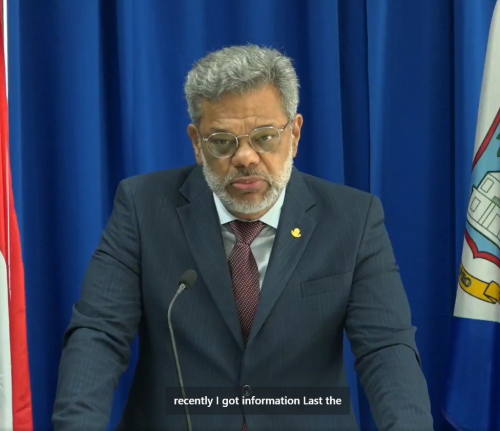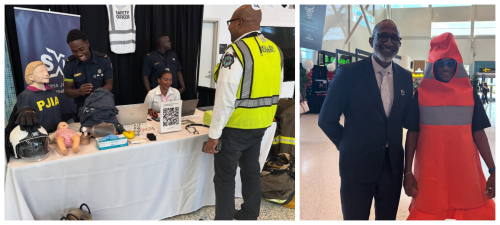 PHILIPSBURG:--- Prime Minister Dr. Luc Mercelina will be travelling to the Netherlands from December 6–13, 2025, as part of a previously scheduled working visit that remains a priority for Sint Maarten. The importance of this mission has increased following a meeting held this afternoon with the Prime Ministers of Curaçao, Mr. Gilmar Pisas, and the Prime Minister of Aruba, Mr. Mike Eman. During that consultation, Prime Minister Mercelina was mandated by his colleagues to represent all three Prime Ministers of the Netherlands, ensuring that he would be on the ground to receive first-hand information on ongoing developments between the United States and Venezuela.
PHILIPSBURG:--- Prime Minister Dr. Luc Mercelina will be travelling to the Netherlands from December 6–13, 2025, as part of a previously scheduled working visit that remains a priority for Sint Maarten. The importance of this mission has increased following a meeting held this afternoon with the Prime Ministers of Curaçao, Mr. Gilmar Pisas, and the Prime Minister of Aruba, Mr. Mike Eman. During that consultation, Prime Minister Mercelina was mandated by his colleagues to represent all three Prime Ministers of the Netherlands, ensuring that he would be on the ground to receive first-hand information on ongoing developments between the United States and Venezuela.
“Given the evolving landscape in our region, Sint Maarten must remain actively engaged at the highest diplomatic levels. My presence in the Netherlands is essential to ensure that our country’s security, safety, perspectives, and priorities are clearly represented,” stated Prime Minister Mercelina; hence my scheduled meeting with the Prime Minister of the Netherlands, Mr. Dick Schoof, coming Monday, December 8, 2025.
The working visit also follows earlier bilateral discussions in New York with Kingdom partners, where cooperation, preparedness, and international developments were among the main topics. Reflecting on the broader regional dynamic, the Prime Minister added, “Considering Aruba and Curaçao’s geographical proximity to areas of heightened concern, it is understandable that my colleagues may face constraints in attending certain sessions in person. Their continued participation through official representatives allows our shared work to continue effectively and cohesively.”
During the visit, Prime Minister Mercelina will take part in a full program of strategic engagements, including consultations with the Minister Plenipotentiary in The Hague discussions with the VNG, and other high-level multilateral meetings. He also intends to meet with the Minister of Foreign Affairs of the Netherlands, Mr. van Weel, to address international matters and developments relevant to the Kingdom, as well as the ongoing tension in the Caribbean.
In addition to these governmental engagements, the Prime Minister will participate in the Inter-Expo conference in The Hague, which will focus on the future prospects of the Kingdom of the Netherlands 15 years after 10/10/10. During this three-day conference, he will contribute to panel discussions alongside regional leaders and experts, including former Dutch Prime Minister Jan Peter Balkenende en Mr. Ernst Hirsch Ballin. He will also deliver a keynote address focusing on the constitutional autonomy.
The Government of Sint Maarten will continue to provide updates as the Prime Minister’s working visit progresses.
 Simpson Bay:--- Princess Juliana International Airport (SXM Airport) proudly kicked off the first day of its annual Safety Fair yesterday, bringing employees and airport partners together for an engaging and informative celebration of workplace safety. The event continues today with its second and final day, and all staff and stakeholders are encouraged to join the activities.
Simpson Bay:--- Princess Juliana International Airport (SXM Airport) proudly kicked off the first day of its annual Safety Fair yesterday, bringing employees and airport partners together for an engaging and informative celebration of workplace safety. The event continues today with its second and final day, and all staff and stakeholders are encouraged to join the activities. HARBOUR VIEW, PHILIPSBURG:--- On Thursday, December 4, 2025, His Excellency Governor Ajamu Baly of Sint Maarten welcomed His Excellency Governor Alfonso Boekhoudt of Aruba and His Excellency Governor Mauritsz de Kort of Curaçao to Sint Maarten.
HARBOUR VIEW, PHILIPSBURG:--- On Thursday, December 4, 2025, His Excellency Governor Ajamu Baly of Sint Maarten welcomed His Excellency Governor Alfonso Boekhoudt of Aruba and His Excellency Governor Mauritsz de Kort of Curaçao to Sint Maarten. PHILIPSBURG:--- The Sint Maarten Library is pleased to announce the receipt of “De Barmhartige Staat” (The Merciful State), the debut novel by Etienne Ys, former Prime Minister of the Netherlands Antilles.
PHILIPSBURG:--- The Sint Maarten Library is pleased to announce the receipt of “De Barmhartige Staat” (The Merciful State), the debut novel by Etienne Ys, former Prime Minister of the Netherlands Antilles.